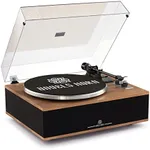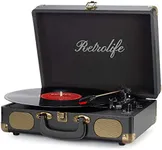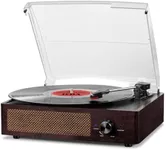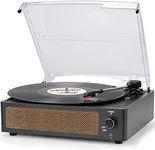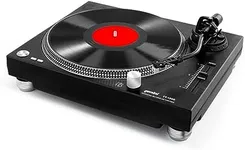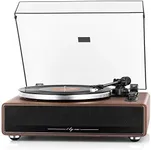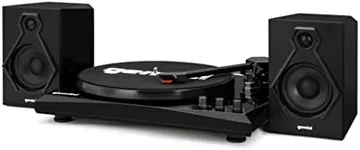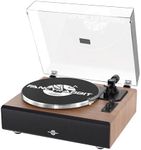Buying Guide for the Best Vinyl Player
Choosing the right vinyl player can be a delightful journey into the world of analog music. Vinyl players, also known as turntables, come in various designs and with different features that can significantly impact your listening experience. To make an informed decision, it's important to understand the key specifications and how they align with your needs and preferences.Drive TypeThe drive type refers to the mechanism that spins the turntable. There are two main types: belt drive and direct drive. Belt drive turntables use an elastic belt to spin the platter, which helps reduce motor noise and vibration, making them ideal for audiophiles seeking high sound quality. Direct drive turntables have the motor directly connected to the platter, providing more consistent speed and durability, which is preferred by DJs for scratching and mixing. If you prioritize sound quality for home listening, a belt drive might be best. If you need durability and precision for DJing, consider a direct drive.
Cartridge TypeThe cartridge is the component that holds the stylus (needle) and converts the grooves on the vinyl into an audio signal. There are two main types: moving magnet (MM) and moving coil (MC). MM cartridges are more common, easier to replace, and generally more affordable, making them suitable for most users. MC cartridges, on the other hand, offer superior sound quality but are more expensive and require a compatible phono preamp. If you're new to vinyl or looking for a good balance of quality and cost, an MM cartridge is a great choice. For audiophiles seeking the best possible sound, an MC cartridge might be worth the investment.
Platter MaterialThe platter is the rotating part of the turntable where the vinyl record sits. Platter materials can vary, with common options including plastic, aluminum, and acrylic. Plastic platters are lightweight and affordable but may not provide the best sound quality. Aluminum platters are more durable and offer better sound isolation, reducing vibrations. Acrylic platters are considered high-end, providing excellent sound quality and stability. If you're looking for a basic setup, a plastic platter might suffice. For better sound quality and durability, consider aluminum or acrylic platters.
Tonearm TypeThe tonearm is the part of the turntable that holds the cartridge and stylus, guiding them across the record. There are straight and S-shaped tonearms. Straight tonearms are simpler and often found on entry-level turntables, providing adequate performance for casual listening. S-shaped tonearms are designed to reduce tracking error and improve sound quality, making them a popular choice for higher-end models. If you're a casual listener, a straight tonearm will likely meet your needs. For more serious listening and better sound quality, an S-shaped tonearm is worth considering.
Phono PreampA phono preamp amplifies the signal from the turntable to a level that can be processed by your speakers or amplifier. Some turntables come with a built-in phono preamp, while others require an external one. Built-in preamps are convenient and simplify setup, making them ideal for beginners. External preamps can offer better sound quality and more customization options, appealing to audiophiles. If you're new to vinyl or prefer a straightforward setup, a turntable with a built-in preamp is a good choice. For those seeking higher sound quality and flexibility, an external preamp might be the way to go.
Speed SettingsTurntables typically support different speed settings to accommodate various types of vinyl records. The most common speeds are 33 1/3 RPM (revolutions per minute) for LPs and 45 RPM for singles. Some turntables also support 78 RPM for older records. It's important to choose a turntable that supports the speeds of the records you plan to play. If you mainly listen to modern LPs and singles, a turntable with 33 1/3 and 45 RPM settings will suffice. If you have a collection of older 78 RPM records, ensure your turntable can accommodate this speed.
Build QualityThe build quality of a turntable affects its durability, performance, and overall listening experience. Higher-quality materials and construction can reduce vibrations and improve sound quality. Look for turntables with solid, heavy bases and well-constructed components. If you plan to use your turntable frequently or want the best possible sound, investing in a model with superior build quality is advisable. For occasional use or a more budget-friendly option, a turntable with decent build quality should suffice.
